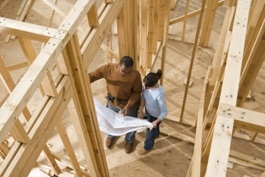 RISMEDIA, April 22, 2011—(MCT)—John Brown believes a home should ease the stress in life, not contribute to it.
RISMEDIA, April 22, 2011—(MCT)—John Brown believes a home should ease the stress in life, not contribute to it.
Brown is the founder of the slow home movement, a philosophy of home design that emphasizes livability and sustainability. It’s about building a home that works for the occupants, not one that’s intended to impress.
The concept was inspired by the slow food movement, with its focus on healthful, sustainable ways of producing and preparing food, explained Brown, an architect, real estate broker and architecture professor in Calgary, Alberta. “You can think of the typical cookie-cutter house as being like fast food”—often supersized and designed to satisfy our craving for beauty, he said. It’s a house that’s designed to seduce us into buying by feeding our fantasies of a more glamorous life, he said, not one that’s necessarily easy to live in or easy on the environment.
A slow home, on the other hand, is reasonably sized and carefully designed to support its occupants. It might have an entry where family members can easily take off their boots, stash their keys and store their backpacks, for example. It might have a living space that encourages people to talk or read, not just watch television or surf the Internet. It’s energy efficient, filled with natural light and designed for easy flow among rooms and access to the outside. “It doesn’t have to be fancy. It doesn’t have to be expensive. It just has to be easy to live in,” Brown said.
Brown and his partners design these types of houses through their firm, Housebrand, and they encourage others to do the same through the educational outreach they call Slow Home Studio (http://www.slowhomestudio.com). Brown and his partner Matthew North have also written a book on the subject, What’s Wrong With This House? Fast Houses, Slow Homes and How to Tell the Difference.
Architect Hallie Bowie has long been guided by a similar philosophy in designing home additions and renovations through her Akron company, New Leaf Home Design. But before learning of the slow home movement recently, she never had a name for it, she said.
Bowie sees the movement as a marriage between green building and the “not-so-big-house” idea, a concept championed by architect Sarah Susanka in a series of popular home-design books.
At its heart, a slow home is really about good design, she said. “It seems to me the slow home has a real values kind of focus,” Bowie said. Its design grows from the occupants’ emphasis on the quality of time they spend with family and friends, not on the quantity of their possessions or their desire to impress people.
A slow home takes different forms for different people. A family who wants less emphasis on television, for example, might create a viewing area that’s separate from the great room, Bowie said. A family who wants to interact more with neighbors might have a front porch.
Brown said slow homes eliminate the little annoyances that tend to make our already harried lives more stressful—annoyances such as entries without closets, bathrooms that open directly to living areas or laundry rooms so close to the back door that people are constantly tripping over laundry baskets when they enter. He likens those kinds of poorly designed elements to an ill-fitting pair of shoes. They just make it harder to get through the day.
Author Shannon Honeybloom also sees a slow home as being a means of providing nurture. To her, the slow home movement involves determining how you want to live or raise children and then creating an environment that supports those goals, a concept she outlines in her book Making a Family Home. “I think the reality of life these days it that life is really fast-paced,” she said. She advocates creating a way of life and a home that put less emphasis on instant information and entertainment and more on encouraging interaction, imagination and learning.
Honeybloom’s concept of a slow home, then, might include elements such as a comfortable reading chair, a backyard garden where the family can spend time together, a computer located somewhere other than where the children usually play and a step stool in the bathroom that enables little ones to wash their own hands or brush their own teeth. Even something as simple as putting a TV in a cabinet, where it’s not always beckoning you to turn it on, can help slow the pace, she said.
Most average homes designed before 1950 are slow by design, Brown said. They’re often simple, “but they work.” But like the food industry, he said, the housing industry started turning out houses—or “products,” as he calls them—designed for short-term sale rather than long-term livability. Dazzling features and square footage sold houses, not abundant natural light, access to the outdoors or a location in a walkable neighborhood.
Ideally, Brown said, a slow home would be designed that way from the start by an architect who takes into consideration the occupants’ interests, needs and habits.
Nevertheless, he said it’s possible to “slow” an existing home. Something as simple as rearranging the furniture can make your home a better fit, he said. Bigger changes can be made over time.
The slow home movement isn’t “a touchy-feely new-age thing,” Brown said, but rather a way of helping consumers get homes that better serve their needs. “We as consumers can make a difference. It’s about an individual sense of empowerment.”
(c) 2011, Akron Beacon Journal (Akron, Ohio).
Distributed by McClatchy-Tribune Information Services.










